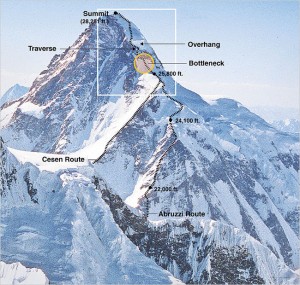What makes K-2 the deadliest mountain in the world? Part-2
Monday, November 21st, 2011 4:44:05 by Naveed A Bari
What makes K-2 the deadliest mountain in the world? Part-2
The deadliest recorded incident in the history of mountain climbing where no fewer than 11 mountaineers and climbers lost their lives on the “Savage Mountain” will perhaps suffice in justifying the magnitude of the lethal force K-2 exerts on the ones who
attempt to conquer it. 2nd August, 2008, broke headlines all across the world when 11 mountaineers and high altitude porters (HAP) were wiped out in a blink of an eye when an overhanging Serac broke loose.
Among all the 8000er’s in the world, K-2 not only is one of the steepest but offers a dangerous combination of Seracs and bottlenecks above 8000meters. This altitude is the threshold of human endurance where lack of oxygen and air pressure cause multiple
abnormalities in a human body ranging from High Altitude Pulmonary Edema (HAPE) and High Altitude Cerebral Edema (HACE) apart from severe frost bite which can often lead to permanent amputations.
HACE is the cerebral sickness where a soft mist gathers inside the human skull causing the brain to malfunction, which thereby increases the risk of injuries two folds. Climbers report that they observe severely deteriorated decision making abilities to
hallucinations at times.
Meanwhile HAPE is the pulmonary sickness where dense fog accumulates inside the lungs due to lack of oxygen, heavy breathing and low atmospheric pressure. This can lead to ruptured lungs if the climber is not shifted immediately to low altitudes for rehabilitation.
On K-2, this 8000meter threshold is probably the starting point from where the toughest of the climbs are encountered. A 400meter stretch of bottleneck, a narrow vertical alley, and several hundred tons overhang of ice has allowed a very few to pass through
live and kicking. The point there onwards is also called as the “Death Valley” and has recorded the most number of causalities at this place.
Graham Bowley’s New York Times Bestseller “No Way Down: Life and death on K-2” is perhaps the most widely recognised account of the gory incident. Bowley states,
“About the time many of the climbers were euphorically topping out — clicking photos and calling their loved ones from K2’s 28,251-foot summit — a giant sérac collapse wiped out the fixed ladders and ropes below, changing the terrain and creating a volatile
funnel ripe for avalanches. Small errors and bad decisions made earlier in the day had set the stage for wide-scale disaster, and an already risky descent became a nightmarish free-for-all.”
The Serac had been hanging at the same spot for decades and although it always was a potent threat to the ambitious climbers, they have gradually started taking it for granted as it never broke off or produced avalanches. The free falling hundreds of tons
of ice not only wiped away several climbers but also left many stranded above it with no way of climbing down. Many of the bodies were never recovered, marking it the most tragic incident in the climbing history.
What made the Serac to break loose is still a mystery while many of the scientists have argued that the changing climate and Global Warming are the two most probable explanations of the incident.
To be continued…
Tags: Annapurna, Concordia, K2, Karakorum, NepalShort URL: https://www.newspakistan.pk/?p=4192

















